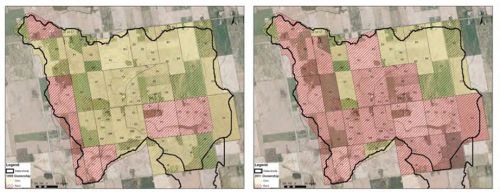Rented farmland: Who's implementing best management practices?

By Jacqui Empson Laporte (Ontario Ministry of Agriculture, Food and Rural Affairs) and Mel Luymes (Farm & Food Care Ontario)
In Ontario, 35 per cent of farmland (roughly 1.6 million hectares or four million acres) is rented – landowners with land suitable for farming rent their land to full-time farmers under short-term or long-term rental agreements. As the images at right show, rented farmland in Ontario is on the rise. While the type of farming practice a farmer uses is often a reason a landowner will rent to a certain farmer, some land is rented because of family operations, historic neighbourly agreements, or simply the highest price per acre. The amount of land rented in a watershed can significantly affect the stewardship practices and the target audience of stewardship programs.
Research and observations indicate that the attention given to rented land may be different than that given to owned land. Soil health, water quality and the economic benefits of good farming practices can only be realized through long-term land management.
Soil is built by diversifying crops and minimizing tillage over many cropping seasons, and structural improvements like grassed waterways and erosion control berms require significant investment. Best management practices, such as cover crops and crop rotation, and the adoption of alternative cropping practices may not be possible due to short-term rental agreements, existing farming practices and the farming equipment used.
Stewardship programs are geared towards landowners; however, some landowners may not be actively engaged in land management practices. If landowners are not actively engaged, it is challenging for local stewardship coordinators to educate, coordinate and encourage the adoption of best management practices. Renters may be the ones in a position to identify the need for best management practices, but have little incentive to make changes.
Communication between landowners and those renting their land is crucial. Landowners need to understand why long-term stewardship goals are important and find renters that share the same long-term conservation goals. As a minimum, the landowner and renter could talk yearly about possible land management practices, including:
- Diversity within a crop rotation
- Inclusion of cover crops
- Tillage practices
- Fertilizer timing and placement
- Erosion mitigation
Soil and water quality could be improved by increasing the length of tenure. The lease agreement could include expected land management practices, such as cropping practices to use, conservation goals, or an agreement for financing larger structural investments, such as erosion control.
With Great Lake Agricultural Stewardship Initiative (GLASI) funding, Farm & Food Care Ontario is working with the Ontario Farmland Trust, conservation authorities, Ontario Ministry of Agriculture, Food and Rural Affairs (OMAFRA) staff, landowning companies, lawyers and farmers to create resources on these important issues. They are looking for ways to promote soil conservation and water management on rented land through a suite of educational and rental agreement resources available at:
